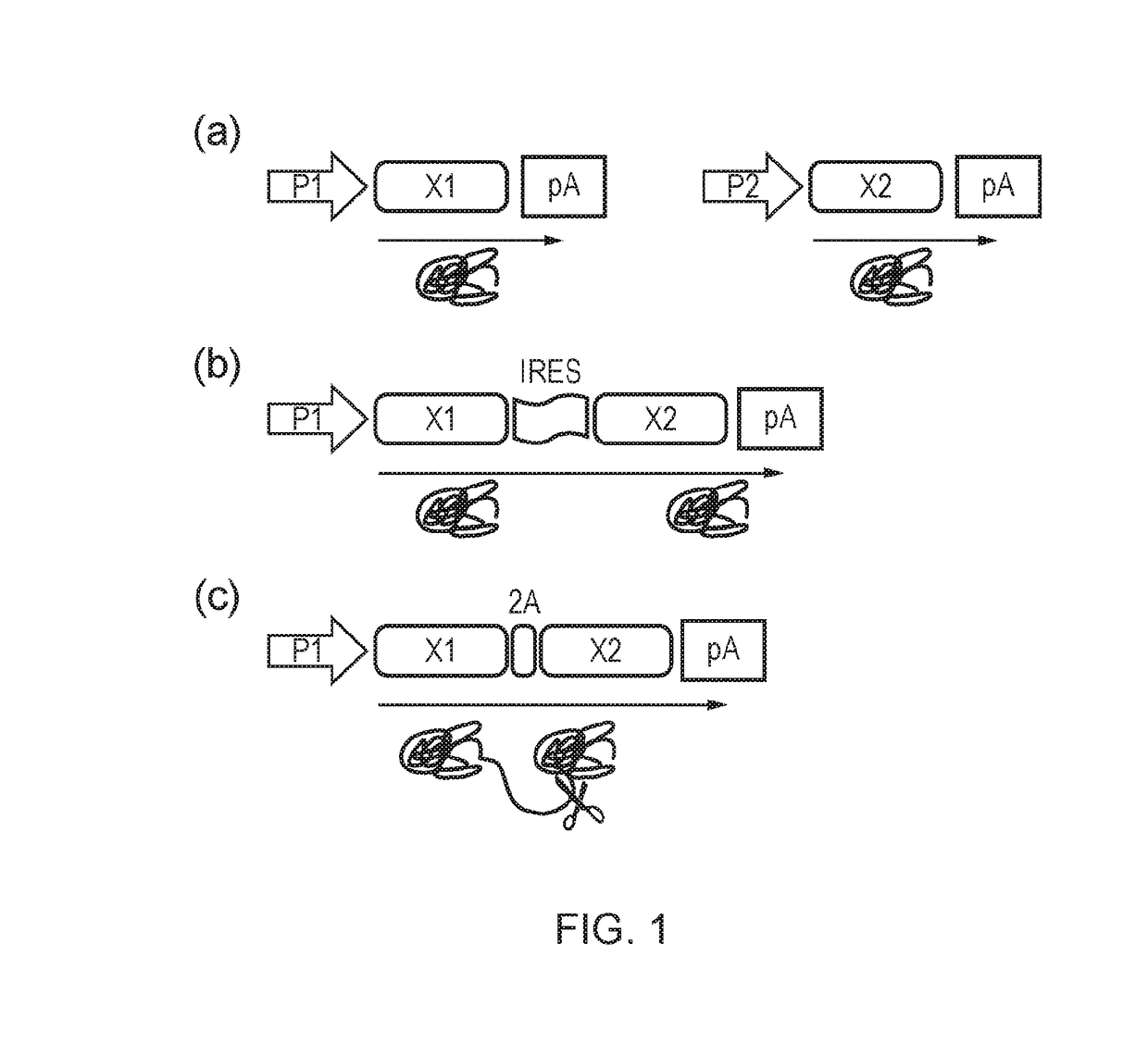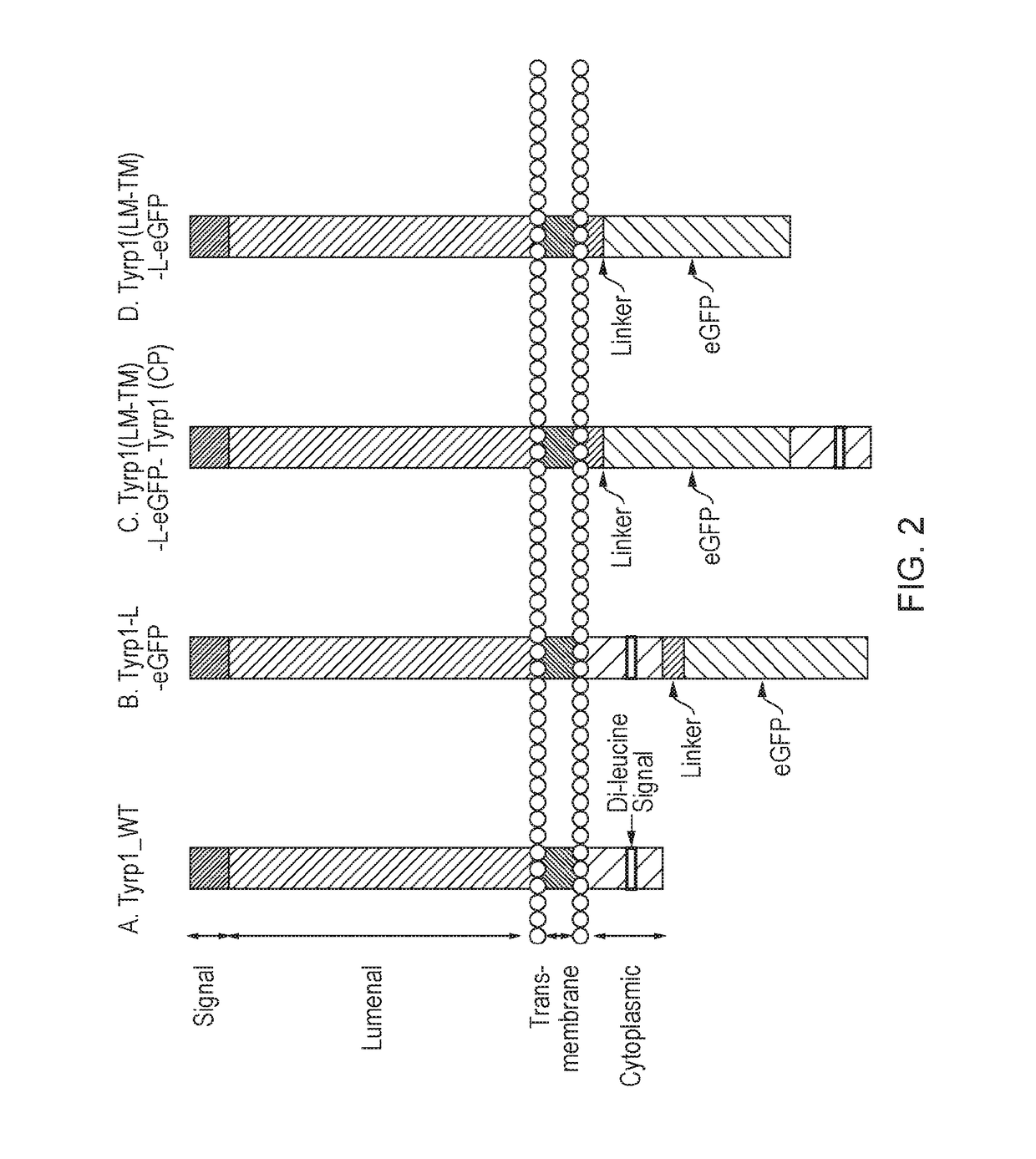Nucleic acid construct
a technology of nucleic acid and constructs, applied in the field of nucleic acid constructs, can solve the problems of difficult approach, difficult multi-transduction of the same cell, and difficult to eliminate the second promoter, and achieve the effect of reducing its trafficking to the cell surface and reducing its half-li
- Summary
- Abstract
- Description
- Claims
- Application Information
AI Technical Summary
Benefits of technology
Problems solved by technology
Method used
Image
Examples
example 1
Dissection of TYRP1 Lysozomal Retention Signals
[0200]The ability of the Tyrosinase-related protein 1 (TYRP1) retention signal to cause retention of a polypeptide when in the context of a more complex endodomain was determined using a number of constructs (FIG. 2). The wild-type construct was compared with constructs where enhanced Green Fluorescent Protein (eGFP) was added or replaced the TYRP1 endodomain. Where eGFP was added, it was placed either after or before the native endodomain so the retention signal was either in its native location (just under the membrane), or distal to it.
[0201]All constructs are co-expressed with IRES.CD34. Staining of transduced SupT1 cells is shown with intracellular and surface staining in FIG. 2.
[0202]It was found that replacement of the endodomain resulted in very bright surface expression, introduction of eGFP after the retention signal to almost no surface expression and introduction before the retention signal to intermediate surface expression...
example 2
Modulation of the Relative Expression of a Transmembrane Protein Co-Expressed from a Single Expression Cassette with a Separate Protein
[0203]An expression cassette encoding two CAR transmembrane proteins was modified such that one of the CAR proteins had the lysozomal retention signal from TYRP1 introduced either proximal or distal to the membrane. Expression of each of these two new variants at the cell surface was compared with that of the original unmodified CAR protein.
[0204]PBMCs were isolated from blood and stimulated using PHA and IL-2. Two days later the cells were transduced on retronectin coated plates with retro virus containing the CD19:CD33 CAR construct. On day 5 the expression level of the two CARs translated by the construct was evaluated via flow cytometry and the cells were depleted of CD56+ cells (predominantly NK cells). On day 6 the PBMCs were placed in a co-culture with target cells at a 1:2 effector to target cell ratio. On day 8 the supernatant was collected ...
example 3
Modulation of Expression using a Retention Signal from the Adenoviral E3 / 19K Protein
[0206]The human adenovirus E3 / 19K protein is a type I transmembrane glycoprotein of the Endoplasmic Reticulum / Golgi that abrogates cell surface transport of major histocompatibility complex class I (MHC-I) and MHC-I-related chain A and B (MICA / B) molecules. The retention motif was identified to be depended on the cytosolic tail of the adenovirus E3 / 19K protein. More specifically, the last 6aa DEKKMP was found to be the most important for retention. The optimal positioning was found to be at the c-terminus of the protein.
[0207]An expression cassette encoding two CAR transmembrane proteins, as described in Example 2, was modified such that one of the CAR proteins had the retention motif from adenovirus E3 / 19K protein. In this experiment, the retention motif on the second CAR in the expression cassette (the anti-CD33 inhibitory CAR).
[0208]Constructs were generated comprising either the entire cytosolic ...
PUM
| Property | Measurement | Unit |
|---|---|---|
| Current | aaaaa | aaaaa |
| Length | aaaaa | aaaaa |
| Length | aaaaa | aaaaa |
Abstract
Description
Claims
Application Information
 Login to View More
Login to View More - R&D
- Intellectual Property
- Life Sciences
- Materials
- Tech Scout
- Unparalleled Data Quality
- Higher Quality Content
- 60% Fewer Hallucinations
Browse by: Latest US Patents, China's latest patents, Technical Efficacy Thesaurus, Application Domain, Technology Topic, Popular Technical Reports.
© 2025 PatSnap. All rights reserved.Legal|Privacy policy|Modern Slavery Act Transparency Statement|Sitemap|About US| Contact US: help@patsnap.com



